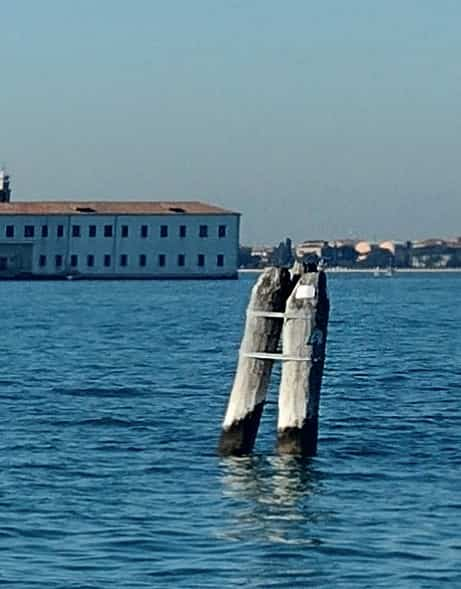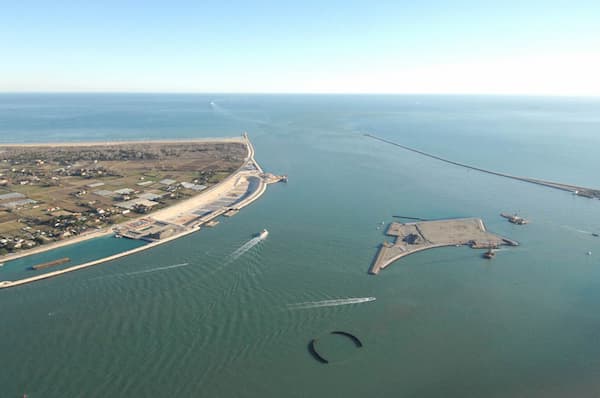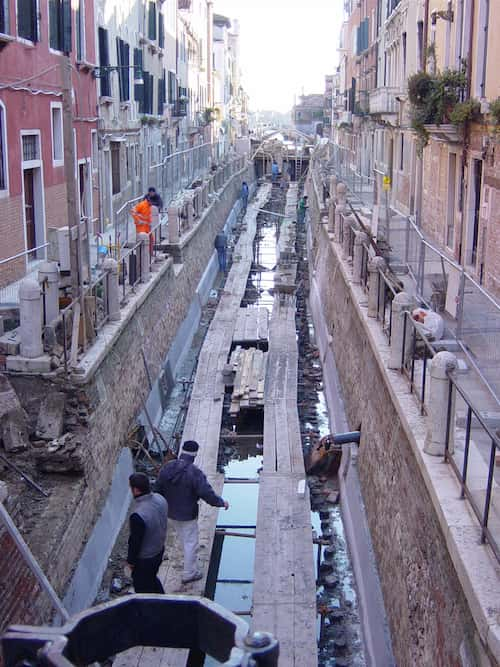How deep are the canals in Venice?
The range of the depth in the smaller canals in Venice varies from almost nothing to around 2 meters (7 feet). Canal Grande, has a depth that can be up to 5 meters (16 feet). Outside of the historical city, but still within the lagoon, it’s much deeper. The Canale della Giudecca, between San Marco and Giudecca, has a maximum depth of almost 15 meters (49 feet), and between S;t Elena and Isola della Certosa on the eastern side it’s more than 20 meters (66 feet) deep. The deepest spot in the lagoon is the Fossa delle Ceppe at the inlet from the Adriatic Sea, between Lido and Pellestrina. There it’s around 50 meters (164 feet) deep.
The deepest part within the borders of the city is obviously Canal Grande. The Water buses and other heavy traffic, need a certain depth. But all canals in Venice with considerable traffic need to be reasonably deep, to not create obstacles even if the tide is low. To that comes the fact that the Venice canals are not evenly deep. Especially the Grand Canal can vary quite a bit. Usually, the shallowest parts are those closest to the embankment. Some of the smaller waterways are really shallow, and at first sight of low tide, the bottom becomes visible.
Here’s a nice map with all the depths of the lagoon. The measurements are from 2002, but it gives you a good idea of the underwater structure.

Calculating the depth considering the tide.
How deep is the water in Venice? When calculating the Venice Canal depth you have to bear in mind the alteration of the tide. Normally we have a variation of 0,5 – 1 meter (1,5 – 3,5 feet) every six hours. Sometimes it’s more and on occasions, it’s as much as 2 meters (7 feet) and more. On the 12th of November 2019, we had the second-highest tide of all time; 187 cm (6 feet 1,6 lbs). And on February 18, 2008, there was a record low tide… – 82 cm (minus 2 feet 8,2 lbs). If you know your maths, that’s 269 centimeters (almost 9 feet) difference.
Now, with the MOSE system installed and working, that figure hopefully will be an unsurpassed record for a long time. But even though the highest tides are a thing of the past, the extreme low tides are not…
On occasion, even parts of Canal Grande display stranded Gondolas and the muddy bottom lies in plain sight. At least along the shoreline. But even if the variation normally isn’t that dramatic, the boats in Venice don’t have the same street map at high tide as they do at low tide. If you should opt for a taxi, when going to your hotel, that is something you should be aware of.
On the other hand, if they can’t get through when the tide is low because there’s not enough water in the canal… It could be that they can’t come through when the tide is high either because the bridges are too low.

How many canals are there in Venice?
There are 178 canals in Venice. This number is somewhat inaccurate, as it isn’t very straightforward to decide what is a canal and what is not. Some of the smaller canals are so small that not even the tiniest boat can pass at low tide. Others still are dead ends and maybe they shouldn’t even have their own name as they’re just an entrance to a private palace. But let’s say somewhere between 150 and 200.
To be even more precise, a small waterway isn’t even called a canal, canale in Italian, or canal in Venetian. The small canals are instead called Rio, or Rii in the plural. In the Venetian language, the word canal is used exclusively for the main waterways… Canal Grande, Canale della Giudecca, Canale di Cannaregio.
Apart from these, the word Canal is also the denomination of all the hidden passages underneath the surface of the lagoon, to and from Venice. These canals were once the main defense system of Venice. When other cities had fortifications, walls, and watchtowers, Venice had its canals, hidden between mud and clay. And keeping them securely hidden was a matter of life and death.

Take a ride with any of the smaller Vaporettos, a Motoscafo, going to Murano, Burano, or any of the other islands away from Venice. If you look outside of the ship, you’ll notice that the vessel strictly follows a row of dolphins. These are normally three thick pilings, arrayed together with a chain or a steel strip. In Venetian, they are called bricole (bricola in the singular). The function is to show where the canal is. In ancient times, you just had to know where the deeper passages were since there was no display whatsoever. But they didn’t have Vaporettos, taxis, and millions of tourists back then.
Are the canals in Venice man-made?
Well, this is an interesting question. No, they’re not all man-made. Actually, none is, in the normal sense. Venice started out as simple buildings on a few sand banks. Between the land there was water. As the city grew, the water between the settlements became ever more narrow, until all that remained was a few feet of water between my house and my neighbor’s house. And the canal was born. This is a somewhat simplified way to explain it, but that’s the way the city was built. Nobody dug the canals. They just formed as the city grew. Later, they had to maintain a navigable depth and secure the embankments. In that sense, you could possibly claim that the Venice canals are man-made.
Some canals in Venice were rivers in the beginning, or, to be more exact, they were the kind of canals mentioned above, deeper parts of the shallow lagoon with a current. Quite a lot of rivers, big and small come down from the mountains and end up in the Venice lagoon. Those rivers run into the lagoon from the land side, and then they continue, eroding along their way until they reach the open sea. Their paths through the lagoon become canals, some with Bricolas, and Vaporettos.
The Grand Canal was one such river, the Brenta, that now runs through Padova. In ancient times it was called Medoacus Maior, and it had another stretch… Still, it was the same river that started high up in the mountains, continued through Bassano di Grappa, Citadella, and Padova, and then finished ìnto the lagoon west of Venice.
How deep is the water in Venice? And are they increasing or decreasing the depth?
In 2017, The Institute of Marine Sciences of the Italian National Research Council (Ismar-Cnr) and the Hydrographic Institute of the Navy (Iim) carried out a survey of the detailed morphology of the canals of the Venice lagoon. The result was two-part: First, a confirmation of what we already knew. For example, the canals in Venice are pretty full of garbage, old refrigerators, shopping carts, and car wheels… A lot of car wheels.
Second, some extraordinary results, especially the effects big vessels have on the bottom of the main transit canals.

The water in the small canals in Venice tends to sediment material on the bottom, and every year they get shallower. But the huge canals leading in and out of the lagoon through the three openings, north, between, and south of the two long islands, Lido and Pelestrina… These canals are getting deeper for every ship passing. The huge hulls with their enormous engines whip the water and the sludge on the bottom.
The result is a mini-tsunami every time a ship passes. The sediments that are pulled up from the bottom are then pushed out into the open sea with tidal forces. And the already very deep canals are getting deeper every time. Something that might seem beneficial for commercial traffic, but really is a disaster from a high-tide point of view. The easier the water can get into and out of the lagoon, the bigger the problems with the high waters in Venice.
Do they do any Maintenance to keep the small canals navigable, and the big canals shallower?
They used to, yes. The canals in Venice used to be overhauled systematically. But lately, there hasn’t been all that much enthusiasm about doing that. Until a few years ago the maintenance was carried out with regularity
that depended only on how long it had been since the last time. The canal was closed off. Then it was drained and thoroughly cleaned. The foundation of the houses, as well as the bottom and the sides of the canal, could be monitored and if necessary, repaired.

Now, since there isn’t enough money in the city Treasury, they have turned to another technique… The wet method, which is nothing other than dredging. This method is good for deepening the canal, but it doesn’t permit any surveillance, maintenance, or repair. It’s a kind of last effort to keep the Venice canals navigable.
The big canals, on the other hand, are much more difficult to fix. You would need to add material instead of dredging it away. The solution, as already mentioned a million times, is to avoid heavy ship traffic inside the lagoon. Unfortunately, somebody placed a huge harbor right there a hundred years ago, and now maybe we just have to live with that.
So maybe they will all dry up then?
No, they will not. But the foundations of the houses, the walls of the canals in Istrian stone, and all the ingenious craftsmanship that has withstood high waters, currents, and subsidence for a thousand years, are at risk. It is not so much the canals. It’s everything else that is facing enormous challenges. And the biggest challenge of them all is the rising sea levels.
… Now, really, are there sharks in Venice?
Well, actually there are… Or there could be. No, not that you would have any possibility to be able to witness one splashing around in Canal Grande. And you shouldn’t avoid taking a dive into the canal for that specific reason… There are other strong reasons why you should avoid swimming in the canals.
A variety of sharks are found in the Mediterranean, and a few observations have been made inside the lagoon. In those cases, they have been seen at the inlets or at least in the deep canals on the eastern side of the lagoon. Sharks have never been spotted inside the city. The Blue shark, the Fox shark, and the most probable… the Blacktip shark, which is known to venture into brackish- and even sweet water on occasions are all possible intruders.
In 1909 a great white shark of 6,6 meters in length, was caught in Lukovo in Croatia on the other side of the Adriatic Sea. In 1978 another great white of 5 meters in length was seen and documented some 10 miles east of Lido. And in 2001 still another great white shark of about the same dimension was witnessed only a mile and a half east of Jesolo on the coast northeast of Venice.
The Great White doesn’t go into brackish waters, so they wouldn’t enter Venice… Fortunately so…